A Portrait of Maria Teresa Gage
A Portrait of Maria Teresa Gage, Lady Craufurd (1762-1832), probably by Chanoinesse Sophie de Tott (1758-1851), 1802/3 (Gage Collection, Firle Place), with notes on other portraits of her family
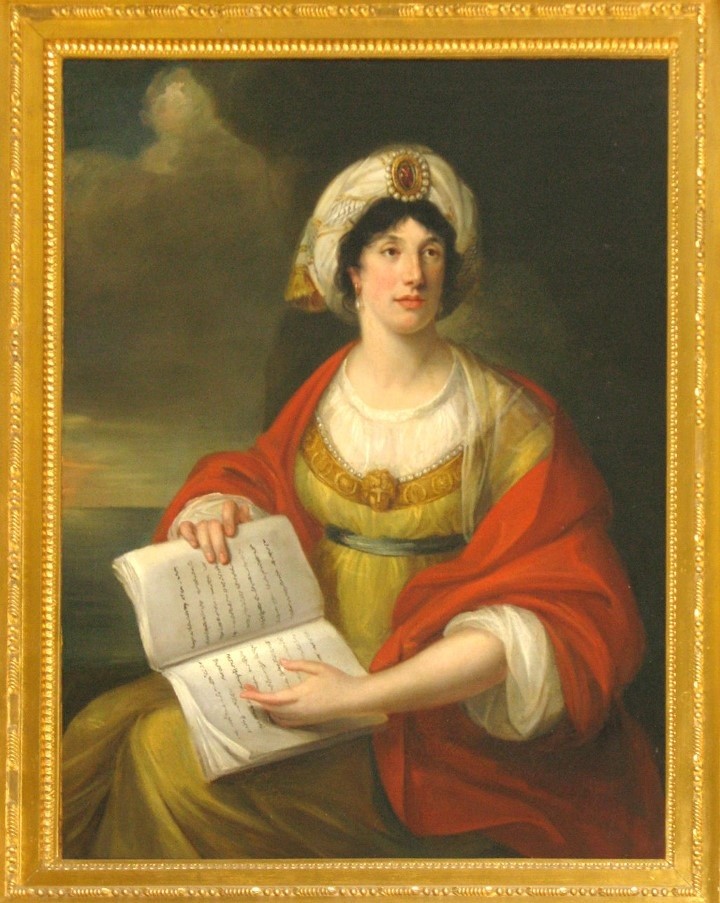
Fig. 1 Attr. to Sophie de Tott, portrait of Maria Teresa Gage, Lady Craufurd (oil on canvas, Firle Place)
Amongst the Gage family’s portraits in Firle Place’s extensive painting collection is a striking late 18th /early 19th century portrait of Maria Teresa Gage, probably by the emigrée French artist, Sophie de Tott, who exhibited a portrait of ‘Lady Crawford’ (sic) at the Royal Academy in 1803 (no.703).[i]
THE SITTER
Maria Teresa Gage was born in Montreal in 1762 and died on 21st April 1832. She was probably named after her paternal grandmother, Benedicta Maria Teresa Hall,[ii] wife of Thomas Gage, the 1st viscount Gage: see fig. 3.[iii] Maria Teresa Gage was the daughter of British army commander and North American colonial official General the Hon. Thomas Gage (1718/9-1787) and his American wife Margaret Kemble (1734-1824), whose father Peter Kemble, a prominent and highly regarded patriarchal figure in New Jersey, was proud of his Turkish connections.[iv] They were married at her father’s New Jersey property on 8th December 1758. In 1791 their eldest son Henry Gage (1761-1808), Maria Teresa’s brother, inherited the viscountcy and the family seat Firle Place, Sussex from General Thomas Gage’s elder brother William Hall Gage (1717/18-1791), the 2nd viscount, who had died without surviving issue.[v] Perhaps significantly, a year later, in 1792, Maria Teresa Gage married Sir James Craufurd, Bt. (1761-1839), later Gregan-Craufurd (after 1812), the 2nd baronet of Kilbirnie (sometimes spelt Kilbirney). By then she was thirty years old; this was a late age to marry, so it is possible that her late uncle had forbidden the match in his lifetime.[vi] In addition there is a curious inconsistency in the date of their eldest son’s birth.[vii] The Craufurds were not a particularly wealthy family, so it was not a great match, and for a long time it has been wondered how the two came to meet and marry.
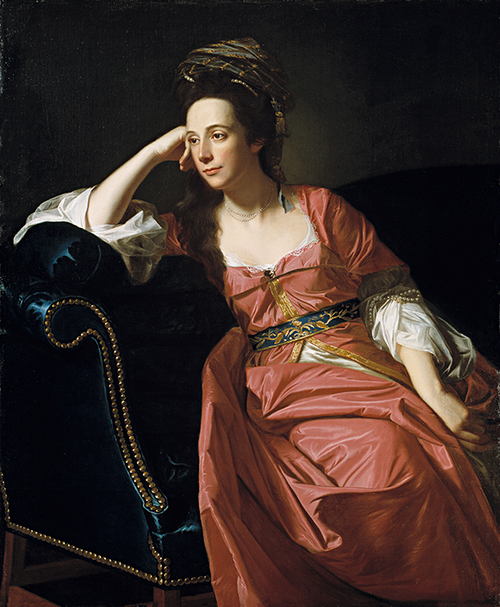
Fig.2. John Singleton Copley (1738-1815), portrait of Margaret Kemble, Mrs Thomas Gage in Turkish Costume, 1771, oil on canvas (Putnam Foundation, Timken Museum of Art, San Diego, California, formerly at Firle Place). She is sitting on a very fashionable sofa, of a shape that Walpole chose for Strawberry Hill; her Turkish costume reflects her family’s pride in its antecedents.

Fig. 3 John Singleton Copley (1738-1815), portrait of General the Hon. Thomas Gage, 1768, oil on canvas (Yale Center for British Art, New Haven, Connecticut)[viii]
MARIA TERESA’S FAMILY BACKGROUND
The answer surprisingly may be a connection through the Light Division of the British Army. Both the Gages and the Craufurds had a long track record of military service. From 1756 to 1759 General Thomas Gage took part in the Seven Years’ War against the French in North America.[ix] See fig. 3. Much of the fighting was in woodland, where camouflage and a more accurate weapon than the musket were crucial to success. The local woodsmen, who dressed in dark green, in contrast to the scarlet of the British Army, were armed with rifles rather than muskets, and Gage took note. In order to secure a permanent colonelcy for himself, Thomas proposed a plan to his superior John Campbell, 4th Earl of Loudoun in 1757, for the creation of a regiment of light infantry better suited to woodland warfare. Loudoun approved the plan, and General Gage began recruiting in New Jersey for the newly raised 80th Foot[x] or ‘Gage’s Light Armed Infantry.’ (This was disbanded in 1763.)[xi] Thomas set up his recruiting headquarters in New Jersey, though it appears his main objective was to spend Christmas with Peter Kemble’s family, given that Peter’s daughter, Margaret had caught his eye.
In 1775 General Thomas Gage and his family returned to England. In 1779 he took a house at 41 Portland Place, London, a recent development laid out by Robert Adam.[xii] In 1781, in the face of a further danger of invasion of England by the French, and in addition to being consulted about the war with the American Colonies, he was asked to return to active service and mobilise troops.[xiii] By the mid-1780s, Gage’s health started to decline, which curtailed his military activities. On 2nd April 1787 he died at his Portland Place house, and was buried in the family crypt under the church at Firle in Sussex on 8th April.[xiv] The two full-length portraits of General Gage and his wife (now in the Palladian Drawing-room at Firle Place[xv]) were painted in 1775 after the couple’s return to England, and were moved to their new house in 1779:[xvi] see figs. 4 and 5. (Gage’s shorter waistcoat and his wife’s dress and hair-style agree with the date of 1775, in contrast to the earlier pair of three-quarter-length portraits.)[xvii]
It is fascinating to conjecture that the Rifle Division (later the Rifle Brigade) was a forerunner of elite corps like the SAS, and that Gage’s intervention may have contributed to the future training of troops and techniques of warfare. Back in England, he was also renowned for his hospitality at Portland Place and on occasion with his brother at Firle Place. In later years he may have entertained another veteran of the British army’s North American campaigns, Lieutenant-General Sir John Moore (1761-1809) and shared innovative ideas regarding light infantry. Alternatively, Moore may have been exposed indirectly to Gage’s ideas during his time in Halifax, Nova Scotia. (Gage was stationed there from 1756 to 1757, and Moore was stationed there from 1779 to 1781 with the 82nd Regiment of Foot[xviii] during the American War of Independence, so their service there did not actually overlap.) However, Moore came by Gage’s ideas, he was the first commander to fully implement them. In 1803 when Moore took command of the Shorncliffe Army Camp he instituted an innovative training regime that led to the development of Britain’s first permanent Light Divisions.
Moore was probably acquainted with Sir James Craufurd’s younger brother Major-General Robert Craufurd (1764-1812), sometimes known as ‘Black Bob’ on account of both his hair and his moods. Both men were sent to suppress the Irish Rebellion of 1798. A year later both took part in the Helder Expedition in the Netherlands, where British and Russian forces invaded the North Holland peninsula in the Batavian Republic (i.e. Holland while under French control) in order to neutralize the Batavian fleet. Following Moore’s death in 1809 during the Retreat from Corunna, it was Craufurd who took command in Spain and who continued Moore’s work with the Light Division during the Peninsular War.
It is also possible that Robert Craufurd may have met General Thomas Gage himself in London; it was a small world, and military men frequented the same clubs. Craufurd, too, was very interested in the training of troops and the proper conduct of war. In 1782 he studied the tactics of Frederick the Great of Prussia (1712-1786) at first-hand in Berlin.[xix] Frederick’s deputy, Prince Leopold of Anhalt-Dessau, was the first man to train troops to march in step since the ancient Romans.[xx] They both may have realised that Prussia needed a more professional army in the face of possible further French expansion.[xxi] It would have been natural for Craufurd, whose army career was his life, to seek an introduction to General Thomas Gage. In this he may have been helped by another Craufurd brother, Lieutenant-General Sir Charles Craufurd (1761-1821), who was also a career soldier and who later worked in the War Office during the Napoleonic Wars.[xxii] If this was the case, then it is likely that Maria Teresa Gage was introduced to her future husband Sir James Craufurd by his younger brother. Following their marriage, Sir James Craufurd and Maria Teresa, now Lady Craufurd, lived at Hengrave Hall near Bury St Edmunds in Suffolk, a property which belonged to the Gage family.
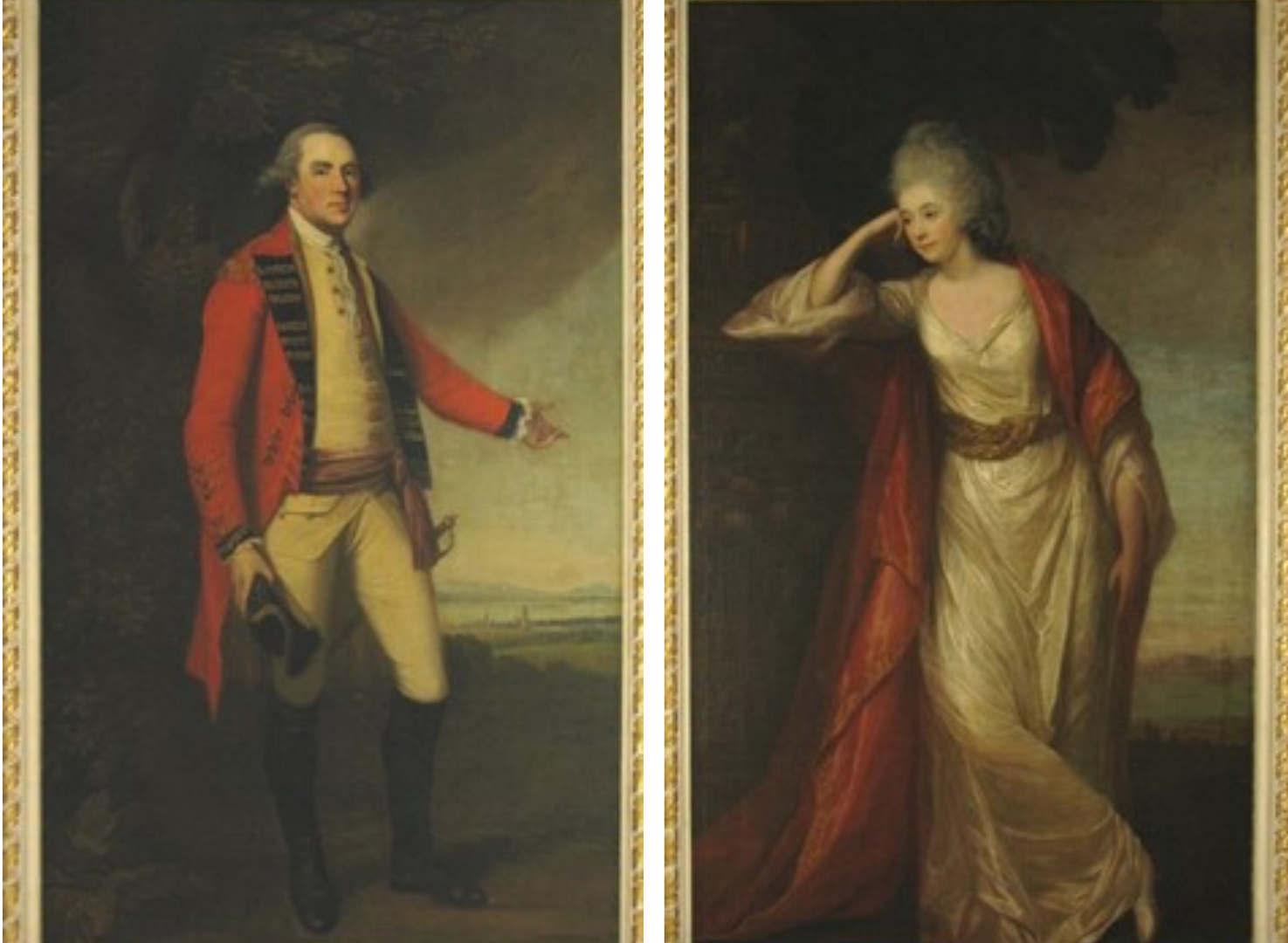
Fig. 4. David Martin (1737-1799), portrait of General Thomas Gage, whole length, 1775 (a pair with the portrait of Mrs Gage). (Firle Place) – Fig. 5. David Martin (1737-1799), portrait of Margaret Kemble, wife of General Thomas Gage, whole length, signed and dated 1775. (Firle Place)

Fig. 6 Studio of Guercino, The Cumaean Sibyl, oil on canvas (National Trust, Nostell Priory)
THE COMPOSITION OF THE PORTRAIT
The portrait of Maria Teresa Gage shows her dressed in an exotic costume. Her outfit is somewhat reminiscent of the fashionable Turkish-style costume that her mother, Margaret Kemble, Mrs Thomas Gage, wore for her 1771 portrait by John Singleton Copley (see fig. 2), but with significant differences.[xxiii] However Maria Teresa Gage is in fact depicted as a Sibyl, in a turban and fancy dress with a scoop neckline, and with a book on her lap and a pensive expression on her face. Tradition has it that there were various Sibyls in antiquity, all of whom had powers of prophecy and wisdom. The artist’s depiction pays homage to the many various images of Sibyls painted by Guercino, which then were a ‘must-see’ for all Grand Tourists to Rome. Throughout the 18thcentury, Guercino’s Sibyls were widely admired, copied and re-interpreted; there is a variant of Guercino’s image (see fig. 6) in the collection of Nostell Priory, which illustrates this. Other Sibyls by Domenichino (such as the one in the Borghese Gallery in Rome)[xxiv] were also popular. It is interesting to speculate how the Gages came to be familiar with these images. Did family members come across Guercino’s Sibyls while tourists in Italy? Or did they admire a copy after Guercino or Domenichino in a British collection? The portrait of Maria Teresa Gage (whose attribution is discussed below) may have been commissioned to celebrate some sort of promotion for Sir James.
THE ATTRIBUTION TO SOPHIE DE TOTT
Sophie de Tott was the daughter of the Hungarian Baron François de Tott (1733-1793), who had French connections. She was born in Constantinople in 1758 and died in Versailles in 1851, after spending some time in London and elsewhere as a result of fleeing from the Terror in France. As an aristocrat, and sister-in-law to the duc de la Rochefoucauld, she was often referred to as Countess, though she was not actually one. She was however a lay religious, with the title of Chanoinesse. The latter title occurs on the label which accompanied the group portrait of the Children of Sir James Craufurd (see below) which credits her with painting it, though the label is difficult to read. The Royal Academy’s catalogues on the other hand used the title of Countess, more familiar to English ears. These catalogues chart her works exhibited between the years 1801 and 1804 (and also give her London addresses over this period). Many sitters were (like herself) French émigrés, such as the Comte d’Artois, the future Charles X of France, whose portrait she exhibited in 1802 (no.616)[xxv], and the Prince de Condé, whose portrait by her is in the family museum at Chantilly; the print of this portrait, made by Bartolozzi, credits her with painting the original.
What must be more than a coincidence is that she actually signed the portrait of Jane Craufurd as a child (fig. 8) which in all probability is one and the same as the Portrait of a Child which she exhibited at the RA in 1803 (no. 701). This was the same year in which she certainly exhibited a portrait of ‘Lady Crawford’ (sic) as no. 703. I think we can take it that this is the portrait at Firle Place, in spite of the wrong spelling (all too frequent in my own personal experience).
SIR JAMES’S AND MARIA TERESA’S FAMILY
Sir James and lady Craufurd had four children, three boys and a girl. The eldest son was Thomas Gage Craufurd (1792/3-1815), followed by Alexander Charles (1794-1838) and the Rev. Sir George William Craufurd (1797-1881). We do not know their daughter Jane’s date of birth exactly, as Debrett’s and Burke’s Peerages consider it bad form to give a lady’s age! The attractive group portrait of the children by Sophie de Tott (1758-1851)[xxvi] in a family descendant’s collection referred to above (see fig. 7) must date from around 1799/1800, as the youngest boy looks to be around 2 to 3 years old. Contemporary memoirs attest that on the 15th June 1815, their daughter Jane Craufurd (circa 1795/6?-1884) danced at the Duchess of Richmond’s Ball in Brussels on the eve of the Battle of Waterloo;[xxvii]so she must have ‘come out’ socially by then. Jane Craufurd married firstly General Sir Christopher Chowne (1771-1834) then after his death the Reverend Sir Henry Dukinfield (1791-1858).[xxviii] Sophie de Tott’s signed portrait of Jane (Fig. 7) was probably made when the sitter was a couple of years older than in the group portrait, very likely in 1802/3 when her mother’s portrait was being painted by the same artist: see below.[xxix]

Fig.7. Chanoinesse Sophie de Tott (1758-1851), portrait of Jane Craufurd, later Dukinfield, c. 1800 (Private Collection)
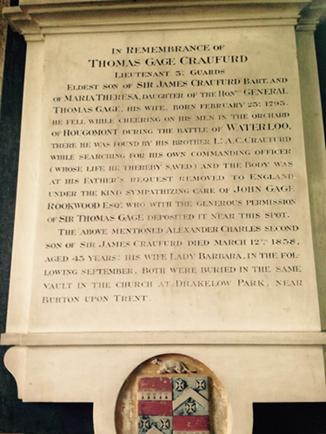
Fig. 8. Commemorative stone plaque in the private chapel at Hengrave Hall, Suffolk in memory of Thomas Gage Craufurd (1792/3-1815). The arms are Craufurd quartered with Gage.
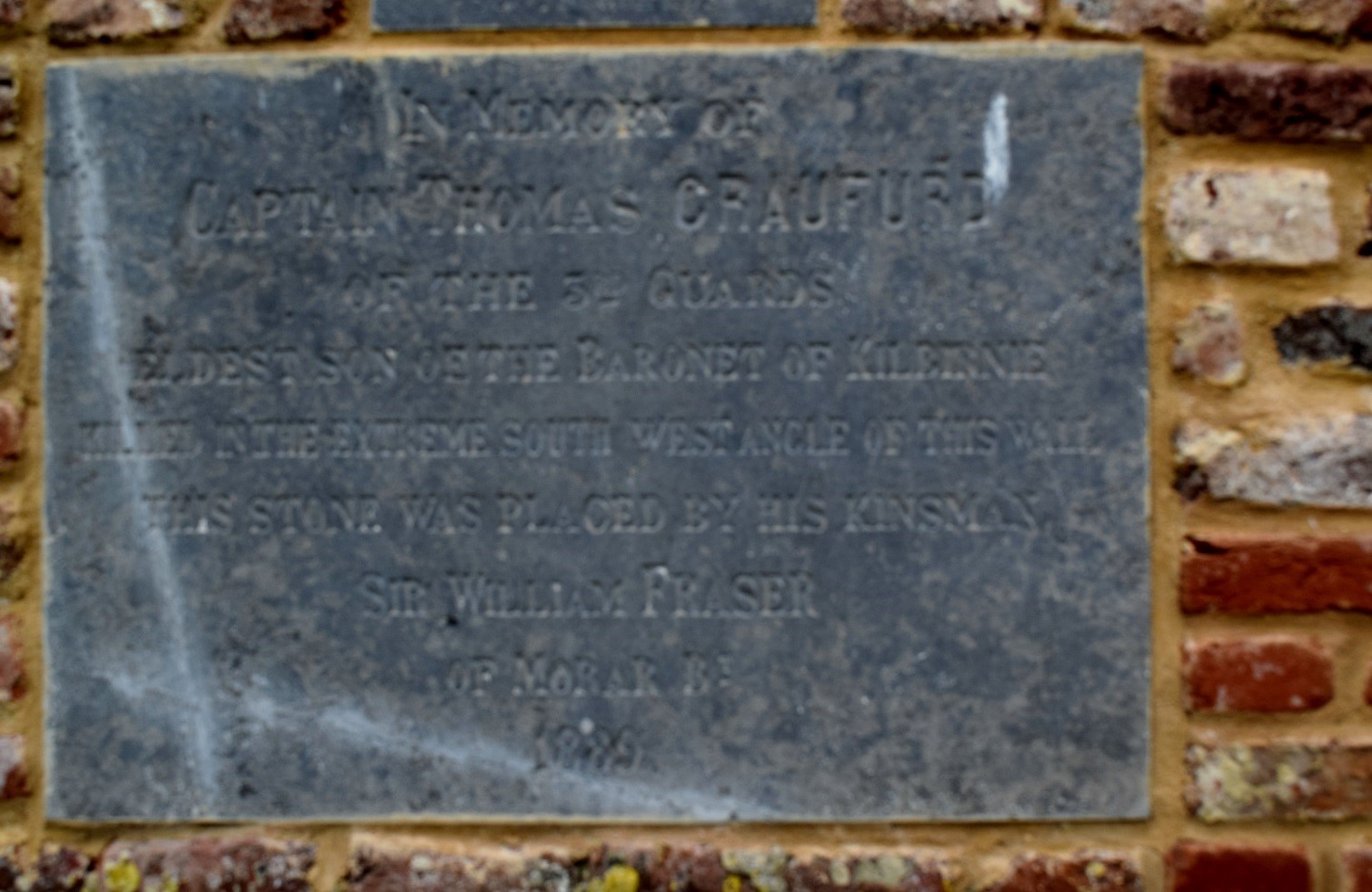
Fig. 9. Memorial plaque at the farmhouse at Hougoumont to Thomas Gage Craufurd (died 1815)
MARIA TERESA’S DESCENDANTS
Maria Teresa Gage and her husband Sir James Craufurd’s eldest son Thomas Gage Craufurd (1792/3?-1815) went into the army like his grandfather and uncles. He was killed on 18thJune 1815 at the Château de Hougoumont during the Battle of Waterloo. Poignantly his body was found in the château’s orchard by his younger brother Lieutenant-Colonel Alexander Charles Craufurd (1794-1838) who was searching for his own commanding officer.[xxx] A commemorative plaque (fig. 8) records that the devastated Sir James Craufurd brought his son’s body back to Suffolk, where it was buried in the private chapel of Hengrave Hall. The Craufurds’ second son Alexander Charles Craufurd died childless in 1838, a year before his father. Consequently, Sir James Craufurd’s third son, the Reverend Sir George Craufurd (1797-1881), became the third baronet. His direct male line died out in 1966. The baronetcy was subsequently inherited by the descendants of Sir James Craufurd’s younger brother Major-General Robert ‘Black Bob’ Craufurd (1764-1812). The ninth and present baronet of Kilbirnie Sir Robert Craufurd (born 1937) is married to the writer of this note.
Later, in 1889, a plaque was put up at the site of Thomas’s death, on the courtyard wall at Hougoumont, by a kinsman, Sir William Fraser of Morar, Bt. He had been too young to take part in the battle, but was fascinated by the subject of Waterloo, and he put up a touching reminder of a young life lost.[xxxi] See fig. 9.
MARIA TERESA GAGE’S OWN GENERATION
The Gage family retains various more informal portraits (on a smaller scale and often in pencil, chalk or watercolour) of members of Maria Teresa’s own generation, which are worth mentioning here. Her brother Henry Gage, the 3rd Viscount Gage, was painted as a child while his parents were still in Montreal, but he and his siblings were brought up in England at Firle by his uncle the 2nd viscount and his aunt Betsey.[xxxii] Military life was precarious and unsettled, and Henry was at least heir presumptive to the title. It has been attributed to Thomas Hudson; the boy is shown at the age of about four to five years with a drum of the sort used to send Army orders to troops, a presage of his future career; see fig.10.
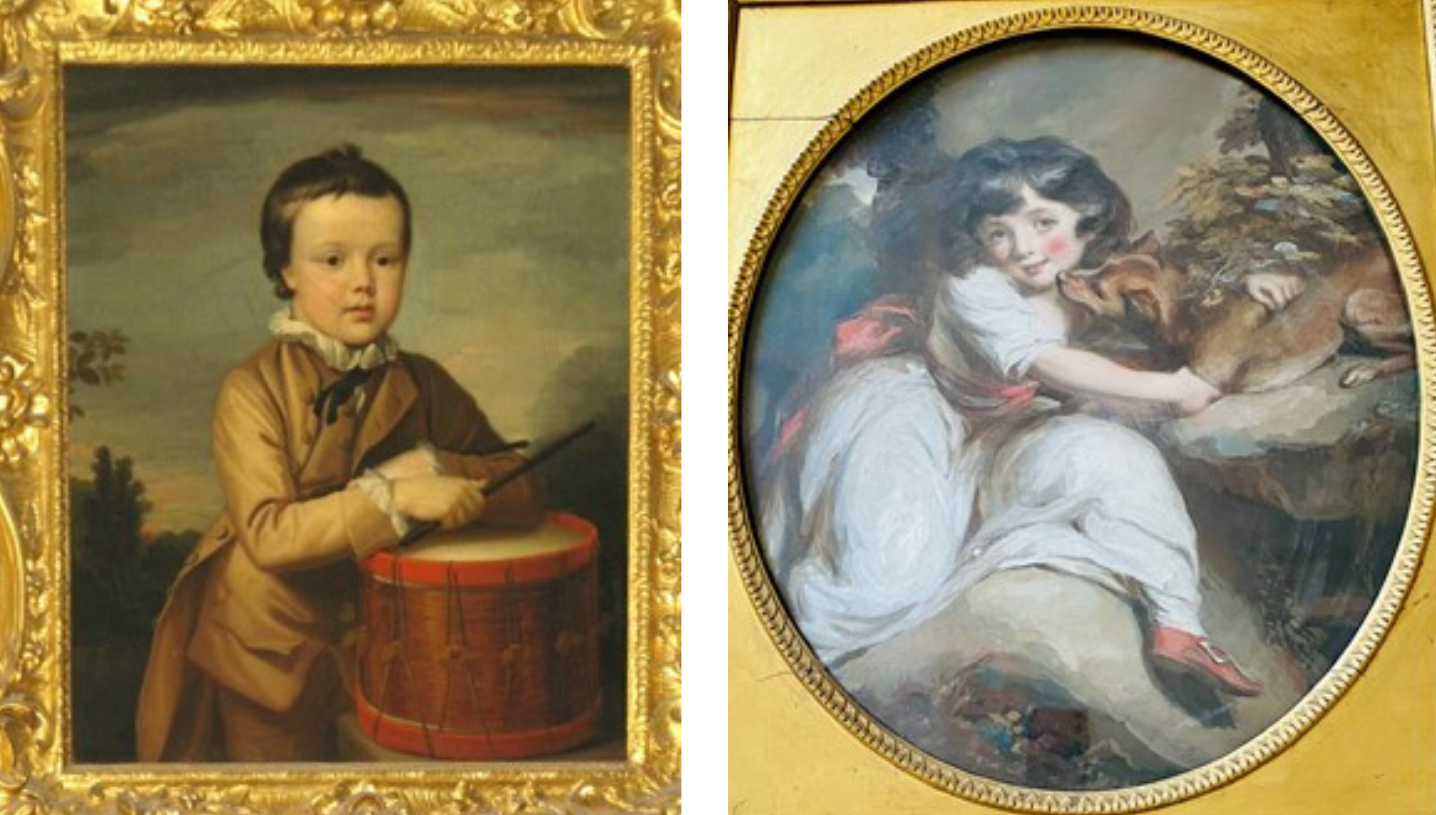
Fig. 10. Attr. to Thomas Hudson (1701-1769), oil on canvas, portrait of Henry Gage (1761-1808) as a child, c. 1765; brother of Maria Teresa, he became the 3rd Viscount Gage (Firle Place)
Fig. 11. Daniel Gardner (1750-1805), portrait of Sophia Ogle as a child with her pet dog; pastel on paper. Her father, Charles, later 2nd baronet and Admiral of the Fleet (1775-1858) married Charlotte Margaret Gage, sister of Maria Teresa. (Firle Place)
Henry followed the family tradition of going into the Army; when a child, he would not have foreseen that he would inherit the viscountcy. (His uncle the 2nd viscount might well have been expected to have more children of his own.) Henry is listed in the Army List of 1790 as a Major on half-pay in the 93rd Foot, part of the regular Army. He would however have had to sell out for practical reasons after he inherited the viscountcy in 1791 at the age of 30 (just as he had to resign officially from the House of Commons as MP for Warwick from 1790-91 on becoming a Peer);[xxxiii]at that point there was not such a danger of invasion. When danger again threatened, he joined the contemporary equivalent of the Territorial Army, serving as Captain in the Sussex Yeomanry in 1798.[xxxiv] Like his father, he too reached the rank of Major-General, in 1805, though the chalk portrait of 1804 shows him in Brigadier-General’s uniform. This was a temporary rank awarded usually for a specific campaign or circumstance. The date 1804 (when the sitter was 43) coincides with Napoleon reneging on the Peace of Amiens and declaring war on Britain again. In fact in 1805 Napoleon was amassing troops in Boulogne in the hope of invading England that year; he was only prevented by Nelson and his Band of Brothers at sea. This may have been enough of a crisis to lead to promotion to this unusual rank.[xxxv] Sadly Henry died in 1808, four years after the portrait; this occurred in London, which suggests natural causes rather than death in battle.[xxxvi] A companion portrait of Henry’s wife (and cousin), Susanna Maria Skinner, exists in the same format; she was the daughter and heiress of William Skinner and his wife Susan Warren,[xxxvii] and a descendant of the Delancey family; this too is dated 1804. They were married in 1789. See figs. 12 and 13. The two portraits may have been commissioned before Henry went to war. Henry and his wife lived between Westbury House, East Meon, Hampshire, as well as at Firle Place.[xxxviii], with visits to another family home, Highmeadow in the Forest of Dean, Gloucestershire, though in 1805 he demolished the house at Highmeadow, preferring that Firle should be viewed as the family seat.[xxxix] Henry’s son the 4thviscount Gage is commemorated by a marble bust.
Finally, there is a delightful pastel portrait of Sophia Ogle with her pet dog by Daniel Gardner (fig. 11), which must have been commissioned by her parents. Her father Charles Ogle, later 2nd baronet and Admiral of the Fleet (1775-1858), married Maria Teresa’s sister Charlotte Margaret Gage, so Sophia was Maria Teresa’s niece. In times of war when husbands and brothers were away fighting, female members often took comfort in each other’s company; it is interesting how many members of the Gage family and their relatives served in either the Army or the Navy.
This collection of family portraits of three generations of sitters was probably not unusual in its time (though the quality of the Copley portraits is outstanding). What is fortunate about this group is that the identity and circumstances of the sitters have been preserved; this is due to the care of the family in looking after its heritage.
Georgina Craufurd, Lady Craufurd of Kilbirnie, August 2019

Fig.12. William Lane (1746-1819), pencil and red chalk portrait of Henry 3rd Viscount Gage as Brigadier-General, signed W.L.,1804 , 15 x 11 cm (Firle Place) – Fig. 13. William Lane (1746-1819), pencil and red chalk portrait of Susanna Skinner, wife of Henry, 3rdViscount Gage, signed W.L. 1804, 14 x 11 cm (Firle Place)
[i] Royal Academy of Arts, A Complete Dictionary of Contributors and their work from its Foundation in 1769 to 1904, 1904, p.314. No other portraits of Lady Craufurd are known to exist, so this must be more than coincidence. The mistake in spelling is regrettably common.
[ii] She was the heiress of Benedict Hall and brought the estate of Highmeadow in Gloucestershire to the Gage family. Portraits of the 1st and 2nd vistounts Gage and their wives are at Firle Place.
[iii] Now at the Yale Center for British Art: accn. No B1977.14.45; see www.collections.britishart.yale.edu/yufind/Record/11668328 .
[iv] For background to the Kemble family, see Collections of the New-York Historical Society for the Year 1884: The Kemble Papers, vol. II, pp. xii-xxi, 8-9 and 20-21 (Publication Fund vol. XVII).
[v] His only son had died in infancy.
[vi] Sir James (as he became in 1797) was rather unstable; he had earlier tried to commit suicide when his potential bride’s father had forbidden the marriage, and later (in 1819) he demanded money with menaces from his aged uncle Quintin Craufurd, which caused him to be deported from France.
[vii] Debrett’s Peerage gives this as 1792, whereas Thomas’s memorial stone gives the date as February 20th 1793. This may suggest a shotgun wedding.
[viii] This portrait hung both in the General’s Portland Place house and later in Mrs Gage’s house in Albemarle Street. Where is went after that is unknown; it was in an American collection until bought by Paul Mellon in 1974 through the Parke-Burnet Galleries Inc. of New York, who advertised it in the Burlington Magazine on 27thOctober the year; see no. 823, vol. CXIII, p. xxvii. Mellon must have passed it to the Yale Center in 1977. A clue to its history before then might be found in Mrs Gage’s Will.
[ix] According to Thomas Gage’s entry in Wikipedia, he owed his position to his brother; he was not involved in the Battle of the Plains of Abraham in Quebec in 1759, but was good at administration.
[x] See John R. Alden, General Gage in America, Baton Rouge, Louisiana, 1948, p.40.
[xi]http://www.academia.edu/7078647/British_Strategic_and_Tactical_Development_During_the_French_and_Indian_War_1754-1759 : Huw Davies, ‘British Strategic and Tactical Development …1754-59’, 2014.
[xii] Marylebone Parish Council Rate Books record that he was the first official resident.
[xiii]On this occasion however Gage was put in command of two Dragoon regiments, rather than Light Division troops.
[xiv] His wife was also buried there in 1824.
[xv] They possibly arrived at Firle Place after Mrs Gage’s death in 1824. She herself had moved to Albemarle Street after General Gage’s death in 1787.
[xvi] The original Portland Place development was designed by the Adam brothers and built in the 1770s.
[xvii] In the 1775 portrait, Gage has a tricorn hat in his right hand instead of the baton which he holds in the 1768 one. 1775 was of course the year he returned to England having largely retired, but his coat is still of military cut. He points to a flatter, calmer scene,with avillage and two churches Bywater, with mountains in the background, in place of the battlefield depicted in the 1768 portrait. He seems to have aged a lot in the interval. A miniature of him is in the National Portrait Gallery, London (no. 4070). A reference to these two whole-lengthportraits (or copies?) being sold at the Mentmore sale on 11th February 1999 in the Heinz archive at the NPG has not been followed up.
[xviii] This was raised in Scotland in 1777 and disbanded in 1784, after the cessation of hostilities in 1783.
[xix] British Library, Craufurd Letters. He translated from the German the official Prussian handbook on the Art of War, taken from Frederick the Great’s own writings: see ed. and trans. Jay Luvaas, Frederick the Great on the Art of War, Ingram Publisher Services US, UK 1999.
[xx] Dennis Showalter, Frederick the Great: A Military History, 2012 (Google “Leopold von Anhalt Dessau marching in step”)
[xxi] Even these preparations did not stop the French from invading Prussia in 1806, but they may have led to Blucher’s decisive involvement in support of the Allies in the Battle of Waterloo.
[xxii] Sir Charles Craufurd worked under the Duke of York, famous in rhyme for marching his men to the top pf the hill, etc. He must have learned of this idea ultimately from General ‘Black Bob’ Craufurd, Sir Charles’s younger brother.
[xxiii] The portrait of Margaret Kemble once hung at Firle Place, and is now in the Putnam Collection, Timken Museum of Art in San Diego, California, USA (accn. no. 1984:001). It was sold through Thomas Agnew & Sons Ltd. (who advertised it in Apollo magazine, January-July 1984) on 24th February 1984.
[xxiv] This particular one was copied by Angelika Kauffman for the Dukes of Gordon, and is now at Lennoxlove Castle, Scotland.
[xxv] Now in the Fitzwilliam Museum, Cambridge. Another of her portraits is of Major Augustus Curzon (1787-1829) at Kedleston Hall, Yorkshire.
[xxvi] Chanoinesse Sophie-Ernestine de Tott (Constantinople 1758-Versailles 1851) as an emigrée exhibited at the Royal Academy in London from 1801-1804. See Neil Jeffares, Dictionary of Pastellists before 1800, online edition www.pastellists.com/Articles/TOTT.pdf . Her portrait of The Children of Sir James Craufurd (c. 1799) shows (clockwise from L.) Thomas (standing), Jane (seated), Alexander Charles (kneeling) and George William (b. 1797, still in baby-clothes), oil on canvas, ht. 1.34m, w. 1.07m. (Private Collection.)
[xxvii] David Miller, The Duchess of Richmond’s Ball, 2005, pp. 60, 89, 150, 156, and 162.
[xxviii] Jane died at 33 Eaton Place, London on 25th May 1884; she may have been buried at St Peter’s Eaton Square, her parish church, rather than her husband’s property at Stanlake House, St Nicholas Hurst, near Reading.
[xxix] No portrait of Sir James Craufurd has so far been found. These portraits may have all been commissioned by the Gage family, who did not approve of Sir James’s over-spending; they once committed him to a sponging-house [debtor’s prison], as a pathetic letter attests.
[xxx] This information appears on Thomas’s memorial plaque.
[xxxi] Claude van Hoorebeeck, Contribution à l’Histoire de la ferme du Goumont, 2008: www.freepub.be.doc/La_Plaque_des_Foot_guards.pdf (available from lady Craufurd if not found online)
[xxxii] Information from Deborah, Dowager Lady Gage.
[xxxiii] Ed. R. Thorne, The History of the House of Commons, 1790-1820, online.
[xxxiv] In addition he became Lt. Colonel of the South Pevensey Volunteers that same year. (Papers in the East Sussex Record Office, no. SAS/G AMS 2535 provide details apparently, but I have not checked with them.) He was promoted to Colonel in 1803, and Lt. Colonel-Commandant in 1804: see No. 15776 The London Gazetteof 2nd February 1805, p. 143. The 93rd was a regiment which was enlarged in 1799 by adding Yeomanry etc. in Sutherland (rather than being founded at that date, as the Internet suggests). See also R. Burnham & R. McGuigan, The British Army against Napoleon, 2010, p. 65 for the 93rd’s subsequent history abroad.
[xxxv] I am indebted to Christopher Bryant for identifying the uniform, and to Christopher Seidler for information on Gage’s early military career.
[xxxvi] Burke, Peerage, 1848, p. xxx; also Biographical Summaries of Notable People,www.myheritage.com/research/record-10182-175066/henry-gage-3rd-viscount-gage .
[xxxvii] She was the daughter of Admiral Sir Peter Warren, KB, who had married Susanna Delancey.
[xxxviii] Susanna had inherited the house from her Warren and Delancey forebears. See www.eastmeonhistory.net/westbury-house/
[xxxix] Remains of the garden survive, according to Parks & Gardens UK’s website, attached to High Meadow Farm.

